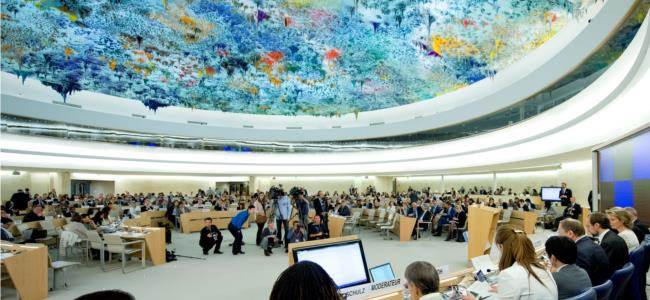The year 2016 is coming to an end, and so is the tenth cycle of the UN Human Rights Council. A new Norwegian supported report sums up the main trends for the Council in 2016 and highlights some of the challenges ahead of 2017.
The report, titled “The Human Rights Council in 2016. Leadership, resolve and cooperation at the UN’s main human rights body”, was launched at a well-attended event in the Palais des Nations this week. The report is written by the Universal Rights Group (URG), while the Norwegian Ministry of Foreign Affairs (MFA) has supported it financially.
The report aims to give a factual overview of the state of affairs for the Council. The first part of the report focuses on the Council’s resolutions and mechanisms, while the second part analyzes how the member states engage and cooperate with the United Nations and its human rights mechanisms. The report is part of the yourhcr.org portal, an online platform created by the Norwegian MFA and URG to promote transparency around the Council and its member states.
The Human Rights Council has – as the finding in the report bear witness to – achieved a lot in 2016, but the year has also been marked by a high work load and many controversies.
As the reports shows, the Council adopted 105 texts during its three regular sessions, and one on Syria during a special session. In addition, a special session is to be held on the situation in South Sudan this week, which probably will lead to the adoption of yet another resolution. The numbers represent a slight increase from 2015, when 95 resolutions were adopted.
The resolutions that were adopted range from protection of Human Rights Defenders, business and human rights, freedom of assembly and association, sexual orientation and gender identity (SOGI), right to education, health, safe drinking water and sanitation to mention a few positive highlights.
Another important feature of this year is the conclusion of the second cycle of the Universal Periodic Review. The success of this human rights mechanism is illustrated by the fact that all State Parties have undergone two reviews, resulting in a total of over 50.000 recommendations.
However, the increasing level of resolutions also results in an increasing workload. During this year’s sessions the Council has held a record number of 153 meetings, putting placing a strain on the United Nations Office at Geneva’s capacity to serve the Council. The Council witnessed another record, namely one of formal amendments to resolutions tabled, with 126 for 2016, compared to 31 in 2016. This represents an increment of 306 %.
As Ambassador Hans Brattskar, Permanent Representative of Norway, pointed out during the launching of the report, this development puts presents a challenge to the Council:
“These developments are concerning and they speak to a more polarized and less cooperative Council. Everyone knows that the number of meetings during the Council’s session is unsustainable. Even for the large delegations. Together with Turkey, Norway has proposed a number of concrete ideas to make the Council’s agenda more effective.“
Some of these concrete ideas were formulated in a joint statement during the Council’s 33rd session in September. The proposals are, inter alia, to biennialise resolutions, avoid repeating language from previous resolutions, making the texts shorter and more operational, and to look at the way the Council manage and conduct panels and general debates.
“73 states signed the latest joint statement in September supporting these measures that could reduce our workload. 2017 could be the year where these proposals could actually be implemented and set into motion.”, Mr. Brattskar said during the launching.
To read the report in full text, please click here.
